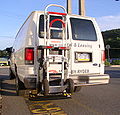2009 Ford E250 Cargo Quick Reference Safety Guide 1st Printing
2009 Ford E250 Cargo Manual
2009 Ford E250 Cargo manual content summary:
- 2009 Ford E250 Cargo | Quick Reference Safety Guide 1st Printing - Page 1
payload capacity.) See the Owner's Guide for more information. Please store this safety guide inside the vehicle along with the Owner's Guide materials. VAN AND WAGON QUICK REFERENCE SAFETY GUIDE This information card provides supplemental safety tips for driving a passenger van and wagon. Please - 2009 Ford E250 Cargo | Quick Reference Safety Guide 1st Printing - Page 2
and/or personal injury. Please refer to your Owner's Guide for additional important information on vehicle weight limits. Towing trailers beyond the maximum recommended gross trailer weight could result in a loss of vehicle control, vehicle rollover and personal injury. Please refer to your Owner

TIREMAINTENANCE
VANANDWAGONQUICKREFERENCESAFETYGUIDE
Thisinformationcardprovidessupplementalsafetytipsfor drivingapassenger vanand
wagon. Please refer toyour Owner’sGuide for additional important safety information.
Everyday, millionsof people put their trust inthe safety andsecurity of FordMotor Company
vehicles.Byfollowingthesafetytipsinthisreferenceguide,youcanhelpensuretheprotectionof
youandyourpassengerswhiletraveling.Thankyoufordrivingwithcareandmakingtheroadssafer.
Make sure this vehicle’s tires are properly inflated and the tread is not worn down. Check
tire pressure using a tire gauge and tread wear at every fuel fill-up. Recommended tire
pressure can be found on the label inside the driver’s side door or door frame. Your
vehicle may be equipped with a Tire Pressure Monitoring System which is NO T a substitute
for manually checking tire pressure. Visit www.checkmytires.org for additional information.
Tires degrade over time depending on many factors such as weather, storage conditions,
and conditions of use (load, speed, inflation pressure, etc.) the tires experience throughout
their lives. In general, tires should be replaced after six years regardless of tread wear.
However, heat caused by hot climates or frequent high loading conditions can accelerate
the aging process and may require tires to be replaced more frequently. You should
replace your spare tire when you replace the road tires or after six years due to aging
even if it has not been used.
Do not use replacement tires with lower load-carrying capacities than the original tires (for
example, E-250 and E-350 vans and wagons are equipped with “E” load-rated tires and
must be replaced with “E” load-rated tires). Exceeding any vehicle weight or load-rating
limitation could result in serious damage to the vehicle, loss of vehicle control, vehicle rollover
and/or personal injury. (Note: Replacement tires with a higher limit than that of the originals
do not increase the payload capacity.) See the O wner’s Guide for more information.
Please store this safety guide inside the vehicle along with the O wner’s Guide materials.
June 2008
First Printing
Q uick Reference
E-Series
Litho in U.S.A.
9C2J19B146 AA
123910_09a_EseriesSafetyCard_022308.qxp:301309 Tweddle
5/6/08
2:54 PM
Page 1





